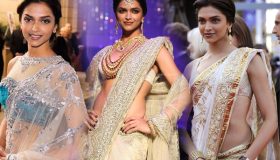The saree, a traditional garment worn by women in South Asia, has transcended centuries to remain a symbol of beauty, grace, and cultural heritage. Originating from the Indian subcontinent, the saree is much more than just a piece of clothing. It represents a blend of tradition and modernity, modesty and allure, making it a unique garment that enhances the beauty of women without showing much skin. This article delves into why the saree is considered so beautiful and seductive, its sex appeal, the traditions it embodies, and the various styles of revealing blouses that complement it.
The Beauty and Appeal of the Saree
Elegant Draping
One of the most captivating aspects of the saree is the way it is draped. Measuring between five to nine yards in length, the saree is wrapped around the body in a variety of styles, each draping method showcasing different regions and cultural nuances. The flowing fabric, which can be made from silk, cotton, chiffon, or other materials, creates a silhouette that accentuates the natural curves of a woman’s body, lending an air of elegance and sophistication.
Modesty with Allure
The saree is unique in its ability to combine modesty with a hint of allure. While it covers most of the body, the way it is draped leaves the midriff exposed and can reveal the contours of the waist and hips. This subtle exposure is often seen as more seductive than overtly revealing clothing, as it leaves much to the imagination and highlights the natural beauty of the wearer.
Versatility in Styling
The saree’s versatility in styling is another reason for its enduring appeal. It can be draped in numerous ways to suit different occasions, from everyday wear to elaborate functions. The choice of fabric, color, and embellishments allows for endless customization, making each saree unique. Whether it’s a simple cotton saree for casual wear or a heavily embroidered silk saree for a wedding, this garment adapts to the wearer’s needs while enhancing her beauty.
The Sex Appeal of the Saree
Sensuality in Simplicity
The saree’s sex appeal lies in its simplicity and the way it highlights the wearer’s femininity without being overtly sexual. The exposed midriff, the graceful fall of the pallu (the end piece of the saree draped over the shoulder), and the way the fabric clings to the body all contribute to a sensual aesthetic that is both subtle and powerful.
Revealing Blouses
While the saree itself is often modest, the blouse worn with it can vary significantly in design, adding an element of seduction. Blouses can range from simple, high-neck designs to more revealing cuts with deep necklines, backless styles, or intricate embroidery. These variations allow women to express their personal style and add a modern twist to the traditional saree.
The Power of the Pallu
The pallu is a crucial element of the saree that adds to its sex appeal. It can be worn in various ways—draped over the shoulder, pleated neatly, or left flowing freely. The way the pallu is styled can accentuate the bust, add a dramatic flair to the overall look, or even provide a sense of mystery by partially covering the face or body.
Cultural and Traditional Significance
Historical Roots
The saree has a rich history that dates back thousands of years. It is believed to have originated in the Indus Valley Civilization, and its evolution over time reflects the cultural and social changes in South Asia. Traditionally, sarees were made from handwoven fabrics and adorned with intricate designs that often carried symbolic meanings.
Regional Variations
Each region in South Asia has its distinct style of saree draping, fabric, and design. For instance, the Kanjivaram saree from Tamil Nadu is known for its rich silk and gold thread work, while the Banarasi saree from Uttar Pradesh is famous for its intricate brocade and zari work. These regional variations highlight the diversity of South Asian culture and the saree’s ability to adapt to different traditions and occasions.
Symbol of Status and Occasion
In many South Asian cultures, the saree is a symbol of status and is worn during significant life events such as weddings, festivals, and religious ceremonies. Bridal sarees, in particular, are elaborate and often passed down through generations as heirlooms. The choice of saree for different occasions reflects social customs and the wearer’s respect for tradition.
Modern Adaptations and Global Appeal
Contemporary Fashion
In recent years, the saree has seen a resurgence in contemporary fashion, with designers experimenting with new fabrics, styles, and draping techniques. Modern adaptations of the saree include pre-stitched versions, saree gowns, and innovative draping styles that make it more accessible to a global audience.
Cultural Influence
The global appeal of the saree has been bolstered by the South Asian diaspora and the influence of Bollywood. Celebrities and fashion icons around the world have embraced the saree, wearing it to red carpet events and fashion shows, further cementing its status as a timeless and versatile garment.
Sustainable Fashion
As the fashion industry moves towards sustainability, the saree stands out as an eco-friendly option. Many traditional sarees are made from natural fibers and handcrafted by artisans, promoting sustainable practices and supporting local economies.
Conclusion
The saree is a quintessential South Asian garment that embodies beauty, tradition, and allure. Its ability to enhance a woman’s beauty without showing much skin, combined with its deep cultural significance, makes it a unique and cherished piece of clothing. Whether through its elegant draping, the subtle sensuality of its design, or the rich traditions it represents, the saree continues to captivate and inspire women around the world.
From historical roots to modern adaptations, the saree remains a symbol of grace and sophistication, proving that true beauty lies in the harmony of tradition and contemporary style. As a timeless garment that transcends cultural boundaries, the saree’s appeal is universal, making it a beloved and enduring icon of fashion.













